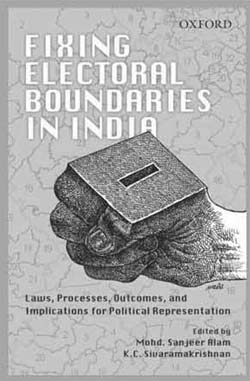Boundary lines between constituencies not only determine who controls parliament or a legislative assembly but their functioning as well. Fixing Electoral Boundaries in India is based on the central idea that drawing constituency boundaries has serious implications for both the practice of politics and the working of democracy. This book underscores the point that demarcating constituencies is not a routine ‘techno-bureaucratic’ exercise but involves ‘philosophical, legal, political, technical and practical’ considerations (p. 3).
The volume highlights the central tension that all delimitation bodies face, that of simultaneously fulfilling the requirements of two fairness principles, namely that of numbers and groups. How can a constituency be fair to the doctrine of ‘one person-one vote-one value’ and at the same time respect the identity and integrity of communities and groups? Demarcating constituencies only on the principle of representing numbers can hurt the interests of groups, who may end up divided and cease to have an effective voice. At the same time, being fair to group interests could on certain counts violate the number principle. Many chapters return to this fundamental tension that confronts delimitation exercises across the world.
Fixing Electoral Boundaries in India provides us a valuable commentary on the politics and tensions surrounding the Fourth Delimitation Commission (FDC). Since the inauguration of the Constitution, the boundaries of India’s parliamentary and assembly constituencies have been redrawn only four times. The book seems to suggest delimitation on a more regular basis would not only prevent vested interests from capturing the system but also enrich the practice of representative democracy.
This book has twelve chapters besides an introduction. The final two chapters make valuable methodological contributions and would probably interest research scholars more than non-specialist readers. While the collection is essentially about the Indian experience, Lisa Handley’s comparative study of delimitation practices in India, United Kingdom, United States and Canada is useful. Besides putting the Indian experience in perspective, she also brings to the foreground the point that the Indian practices have consistently violated the principle of all votes having equal weight.
The volume reproduces a chapter ‘The Concept of Constituency’, from Andrew Rehfeld’s highly original and much cited The Concept of Constituency: Political Representation, Democratic Legitimacy, and Institutional Design published by Cambridge University Press. Rehfeld underlines the fact that constituencies define the people in a democracy, and the way constituencies are demarcated lies at the heart of the theory of representative democracy. He suggests that constituency design need not always be territorial but could be imagined in other ways as well. It is a pity that none of the chapters in the volume which grapple with constituency design issues have engaged with the issues raised here.

